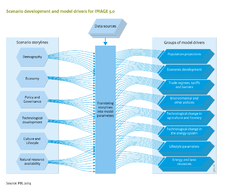Drivers/Policy issues: Difference between revisions
< Drivers
Jump to navigation
Jump to search
No edit summary |
No edit summary |
||
| Line 3: | Line 3: | ||
|PageLabel=Drivers and types of scenarios | |PageLabel=Drivers and types of scenarios | ||
|Sequence=4 | |Sequence=4 | ||
|Reference=OECD, 2012; Moss et al., 2010; Van Vuuren et al., 2012; | |Reference=OECD, 2012; Moss et al., 2010; Van Vuuren et al., 2012; | ||
|Description=<h2>Scenario approaches </h2> | |Description=<h2>Scenario approaches </h2> | ||
Under baseline conditions scenario drivers are typically assumed to develop either along a pathway that is considered a best guess translation of current trends into the future. Alternatively, multiple contrasting scenarios can be considered to explore the range of plausible future trends. The former approach is chosen in many studies, such as the [[OECD Environmental Outlook to 2050 (2012)|OECD Environmental Outlook]] ([[OECD, 2012]]), with the specific aim to serve as starting point for policy interventions aiming to improve the baseline outcomes within and across sectors and domains. The latter approach recognizes structural uncertainties in how the world might unfold, and aims to explore how such uncertainties would play out in future ranges of outcomes. They also serve to investigate how robust policy interventions play out under different future conditions. Examples of multiple baseline studies are (IPCC, 2000), (MA, 2005). See Figures 3.2*** and 3.3*** for illustrative results from the so-called Shared Socio-economic Pathways (SSPs), recently developed to support climate change research across different research communities. ([[Moss et al., 2010]]; [[Vuuren et al., 2012]]). An important element of the SSPs are the qualitative narratives or storylines characterizing alternative futures. From there, assumptions are made about internally coherent sets of scenario drivers, and finally key model drivers such as population and GDP growth factors. | Under baseline conditions scenario drivers are typically assumed to develop either along a pathway that is considered a best guess translation of current trends into the future. Alternatively, multiple contrasting scenarios can be considered to explore the range of plausible future trends. The former approach is chosen in many studies, such as the [[OECD Environmental Outlook to 2050 (2012)|OECD Environmental Outlook]] ([[OECD, 2012]]), with the specific aim to serve as starting point for policy interventions aiming to improve the baseline outcomes within and across sectors and domains. The latter approach recognizes structural uncertainties in how the world might unfold, and aims to explore how such uncertainties would play out in future ranges of outcomes. They also serve to investigate how robust policy interventions play out under different future conditions. Examples of multiple baseline studies are (IPCC, 2000), (MA, 2005). See Figures 3.2*** and 3.3*** for illustrative results from the so-called Shared Socio-economic Pathways (SSPs), recently developed to support climate change research across different research communities. ([[Moss et al., 2010]]; [[Van Vuuren et al., 2012]]). An important element of the SSPs are the qualitative narratives or storylines characterizing alternative futures. From there, assumptions are made about internally coherent sets of scenario drivers, and finally key model drivers such as population and GDP growth factors. | ||
===Scenario examples=== | ===Scenario examples=== | ||
Revision as of 15:29, 11 December 2013
Parts of Drivers/Policy issues
| Projects/Applications |
| Models/Databases |
| Relevant overviews |
| Key publications |
| References |
